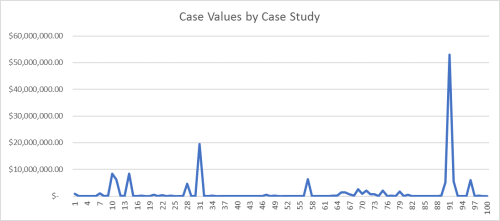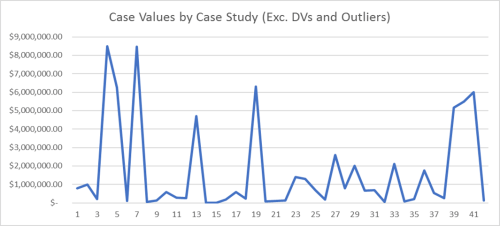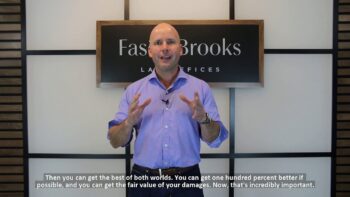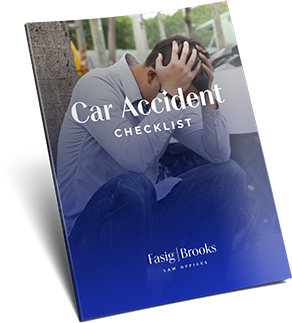Referencing the sample of 100 Products Liability cases across the State of Florida that we’ve statistically dissected, we saw two high-value outliers: $19.5 million dollars and $53 million dollars. This sample had an unsually large range; to determine which cases qualified as outliers, we referenced the visual trend seen in line graphs such as in Figures 1 and 2, and statistical measures such as average case value and data skewness. We found that all cases, apart from the two outliers, had awards of less than $9 million dollars. This important trend directed us to seeing the outliers clearly. Because this sample had such high outliers, we have made two line graphs, the first one including defense verdicts and outliers and the second excluding them.

Figure 1. Here, you can see the outliers of the sample as the two highest peaks. This graph includes DVs and the outliers.

Figure 2. This graph shows the overall trend of the 42 cases left after excluding defense verdicts and the outliers
Outliers are values that are far above (or below) the average or normal trend of any data set. These outliers can direct a researcher to analyze that point in the determination of why it would be irregular in terms of the trend of values seen in a given set. In jury verdict research, outliers direct anyone analyzing jury verdicts to a case to analyze the facts of that case and determine why that case received a higher verdict or settlement in a jury trial setting than another comparable case. High-value outliers must be studied in terms of their ability to skew the average of a data set. Because outliers often cause the average case value of a sample to change, one must always calculate averages with and without the outliers for the most representative average of a data set.
Outlier cases commonly have specific facts that permit their deviation from the overall trend of the other cases in the sample. To exemplify this, let’s look at the outliers from the sample, beginning with the highest-valued one.
In Case Study 91 (Fig. 1), we were presented with a female plaintiff in Hillsborough County in 2013. Her husband was operating a 1997 Ford Explorer designed and manufactured by the defendant, Ford Motor Company, when he drove over a patch of water, hydroplaned, spun, and crashed into the center guardrail numerous times. The plaintiff was a restrained rear-seat passenger when her seat back allegedly failed and deflected backwards, unlatching her and ejecting her out of the rear window. Claiming negligence and strict liability against the Ford, and claiming failure to maintain the roadway against the second-named defendant, the Florida Department of Transportation, the plaintiff and her husband filed suit. They claimed that the Explorer was defective based on the failure of the rear seatbelt, rear seat back, and the vehicle’s dangerous propensity to roll over. Ford claimed that the plaintiffs failed to state a claim for which relief could be granted. This case was resolved in a comparative negligence verdict with a 40% negligence apportionment to the plaintiff and her husband and a 60% apportionment to Ford, the second-named defendant was found not to be liable. This case’s $53 million-dollar award was broken down where $10 million dollars was awarded for past medical expenses, $1.703 million dollars were awarded for lost wages, $38,297,000 was awarded for pain and suffering and $3 million dollars were awarded for the plaintiff’s husband’s loss of consortium.
Case Study 31 (Fig. 1) was scant in information, however we were presented with a 29-year-old female plaintiff who went to trial in 1988 against the defendant, Jeep Corporation. The plaintiff suffered quadriplegia when the vehicle in which she was a passenger rolled over after colliding with another vehicle. She claimed that the defendant was negligent in the design of the vehicle. This case was resolved with a true plaintiff’s verdict in the amount of $19.5 million dollars, $10 million of which was awarded for punitive damages.
To learn more about the average case value attributed to all Products Liability cases in this sample, please click here.
If you’re a potential client, or an attorney seeking a second opinion, and would like to discuss the value of your case please feel free to call me anytime at (850)-244-3310.





